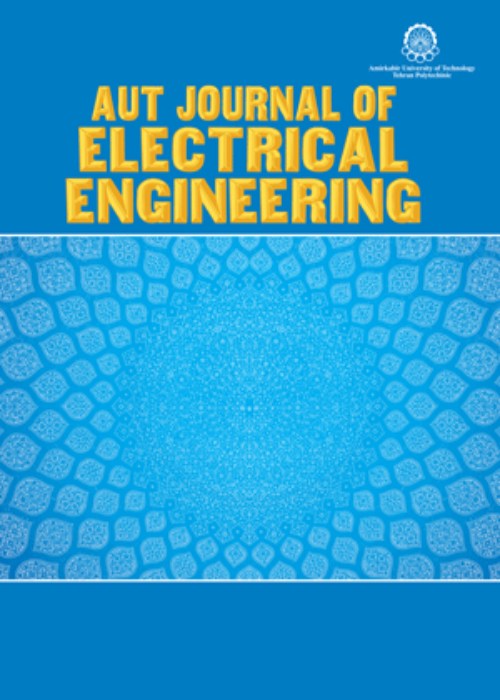فهرست مطالب

Amirkabir International Journal of Electrical & Electronics Engineering
Volume:48 Issue: 2, Summer - Autumn 2016
- تاریخ انتشار: 1395/09/30
- تعداد عناوین: 6
-
-
Pages 63-70In this paper a new low profile Substrate Integrated Waveguide (SIW) probe-fed H-plane horn antenna structure with improved gain is proposed. The proposed antenna consists of two waveguides including a rectangular and a taper one, in which both, first and third modes of the structure are simultaneously excited leading to a uniform field distribution along the radiating aperture of the antenna and in turn, its directivity is highly improved. Moreover, using the coaxial probe feeding of the structure, spurious radiation due to feeding network is suppressed. The antenna structure is numerically investigated using a software package. A prototype of the structure is made by a thin substrate using TLY031 substrate and it was successfully tested. A very good agreement is obtained between simulated and measured results. The measured results show 10.48 dBi gain which is 4.9 dBi higher than gain of a conventional SIW horn is obtained at 27.8 GHz.Keywords: Aperture Antenna, Horn Antenna, Substrate Integrated Waveguide (SIW)
-
Pages 71-80As a response to a growing interest in RFID systems such as Internet of Things technology along with satisfying the security of these networks, proposing secure authentication protocols are indispensable part of the system design. Hence, authentication protocols to increase security and privacy in RFID applications have gained much attention in the literature. In this study, security and privacy of the recent well-known HMAC-based RFID mutual authentication protocol, is analyzed. We prove that this protocol is not secure against various attacks and also does not provide untraceability. Also, in order to improve the performance of the mentioned protocol and enhance the security of RFID users, a more effective and secure authentication HMAC-based protocol is presented. Furthermore, security of our protocol is explored against different attacks such as; the replay attack, the tags ID exposure, the spoofing attack, DoS attack and traceability attack. It is shown that our proposed protocol is safe against the attacks. Finally, the security of the presented protocol is compared with some well-known related protocols.Keywords: RFID systems, authentication protocols, HMAC, security analysis
-
Pages 81-92Against the range-dependent accuracy of the tracking radar measurements including range, elevation and bearing angles, a new hybrid adaptive Kalman filter is proposed to enhance the performance of the radar aided strapdown inertial navigation system (INS/Radar). This filter involves the concept of residual-based adaptive estimation and adaptive fading Kalman filter and tunes dynamically the filter parameters including the fading factors and the measurement and process noises scaling factors based on the ratio of the actual residual covariance to the theoretical one. In fact, due to the unknown and fast-varying statistical parameters of the radar measurement noises and their nonlinear characteristics, applying a conventional Kalman filter to INS/Radar data fusion yields a low performance navigation and in-flight alignment. The Monte Carlo simulation results of the integrated navigation system on an interceptor missile trajectory indicate the new algorithm has an effective performance in face of nonlinearities and uncertainties of the tracking radar measurements. these results allow to know whether the fine in-flight alignment and high performance navigation can be possible for the long-range air defense missile using the low-cost INS/Radar system without aiding global navigation satellite system signals or not.Keywords: Adaptive Kalman Filter, Inertial Navigation, in, flight alignment, Radar
-
Pages 93-100In this paper, the problem of secure transmission in two-hop amplify-and-forward (AF) systems with an untrusted relay is investigated. To prevent the untrusted relay from intercepting the source message and to achieve positive secrecy rate, the destination-based cooperative jamming (DBCJ) technique is used. In this method the destination sends an intended jamming signal to the relay. This jamming signal helps protecting the source message from being captured reliably at the untrusted relay, while the destination cancels itself intended jamming signal. The optimal power allocation (OPA) technique is considered for the presented system. It is observed that the objective function is a quasiconcave function at high signal-to-noise-ratio (SNR) regimes. Based on this OPA technique, we study the ergodic secrecy rate (ESR) and the secrecy outage probability (SOP) of the system when the source and relay are equipped with a single antenna while the destination is equipped with largescale antenna arrays (LSA). Using the achieved closed-form expressions, one can evaluate the performance of the secure system easily and fast and also, they provide significant insight for system design. Finally, simulation results indicate the accuracy of the derived expressions.Keywords: Physical layer security, Optimal power allocation, Untrusted relay, Destination, based cooperative jamming
-
Pages 101-112Accuracy of inertial navigation system (INS) is limited by inertial sensors imperfections. Before using inertial sensors signals in the data fusion algorithm, noise removal method should be performed, in which, wavelet decomposition method is used. In this method the raw data is decomposed into high and low frequency data sets. In this study, wavelet multi-level resolution analysis (WMRA) technique is used as an efficient pre-filter method for inertial measurements to improve the performance of INS. This technique improves navigation accuracy, eliminating high frequency noise of inertial measurements. Optimum values of the level of decomposition are selected to obtain minimum error. Successfully performing the de-noising method improves the sensors signal-to-noise ratios and removes short term errors mixed with motion dynamics and finally provides cleaner and more reliable data to the INS. Performance of an error state Kalman filter based GPS/INS integrated navigation system with the loosely coupled structure is studied using real measurement while GPS outages. Results show that the average value of the root mean square of the position errors using the WMRA procedure is reduced about 14% compared to those using the raw inertial measurements.Keywords: GPS, INS integrated navigation, GPS outages, wavelet analysis, error state Kalman filter, level of decomposition
-
Pages 113-126In this paper robust PID control of fully-constrained cable driven parallel manipulators with elastic cables is studied in detail. In dynamic analysis, it is assumed that the dominant dynamics of cable can be approximated by linear axial spring. To develop the idea of control for cable robots with elastic cables, a robust PID control for cable driven robots with ideal rigid cables is firstly designed and then, this controller is modified for the robots with elastic cables. To overcome vibrations caused by inevitable elasticity of cables, a composite control law is proposed based on singular perturbation theory. The proposed control algorithm includes robust PID control for corresponding rigid model and a corrective term. Using the proposed control algorithm the dynamics of the cable driven robot is divided into slow and fast subsystems. Then, based on the results of singular perturbation theory, stability analysis of the total system is performed. Finally, the effectiveness of the proposed control law is investigated through several simulations on a planar cable driven robot.Keywords: Cable robots, Elasticity, singular perturbation, Stability analysis


